The digestive system in human beings is made of alimentary canal and some external glands like liver, pancreas and salivary glands which help in digestion of food. The alimentary canal is a long tube having a length of 8-10 meters. The various organs of human digestive system are: mouth, buccal cavity, oesophagus, stomach, small intestine (it consists of two parts duodenum and ileum), large intestine (it consists of colon and rectum) and anus.
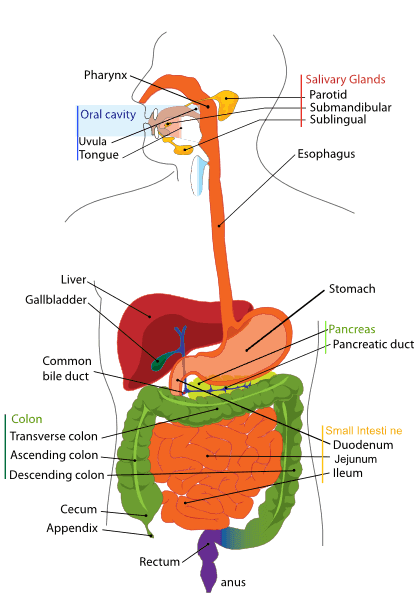
Now, let’s discuss the various processes of nutrition taking place in the digestive system of human beings.
1. Ingestion
In human beings ingestion of food takes place through mouth, which is bounded by two movable lips.
2. Digestion
In human beings digestion starts in the mouth. The mouth consists of buccal cavity, teeth, tongue and salivary glands. Buccal cavity is the space between two jaws. Both the jaws have teeth which take part in cutting and grinding of food. Three pairs of salivary glands open into buccal cavity. Their names are parotid (situated below the ears), submaxillary (situated at the angles of lower jaw) and sublingual (situated below the tongue). The salivary glands produce saliva. The saliva contains enzymes ptyalin which converts starch present in the food to simple sugars. Saliva also helps in lubrication and softening of food.
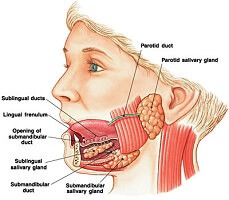
Saliva is mixed with food by tongue present at the base of buccal cavity. Tongue also performs a number of other functions such as:
1) It helps in chewing of food
2) It helps in speech
3) It helps in perceiving taste of food
4) It helps in swallowing the food
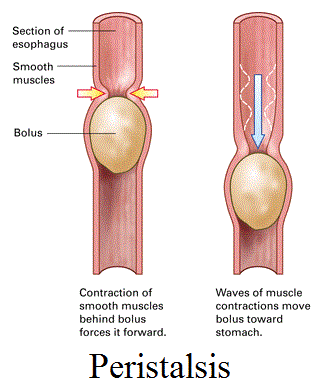 The partially digested food in the mouth is swallowed by the tongue and goes into the stomach through oesophagus or food pipe. When the partially digested food enters oesophagus the walls of the oesophagus starts rhythmic contraction movements called peristalsis. By these peristaltic movements the partially digested food is pushed into the stomach. Oesophagus does not possess any digestive gland. However, it secretes mucus for further lubrication of food.
The partially digested food in the mouth is swallowed by the tongue and goes into the stomach through oesophagus or food pipe. When the partially digested food enters oesophagus the walls of the oesophagus starts rhythmic contraction movements called peristalsis. By these peristaltic movements the partially digested food is pushed into the stomach. Oesophagus does not possess any digestive gland. However, it secretes mucus for further lubrication of food.
From the oesophagus the partially digested food enters the stomach which is the widest part of the alimentary canal. It is a J shaped organ that lies on the left side just behind the diaphragm. The food is further broken down in small pieces by churning movements of stomach. The stomach contains a number of gastric glands which secrete gastric juice.
The gastric juice consists of three substances: proenzyme pepsinogen, hydrochloric acid (HCl) and mucus. The presence of HCl in gastric juice makes the partially digested food acidic and prevents the growth of bacteria in food. HCl also converts the proenzyme pepsinogen present in the gastric juice into proteolytic enzyme pepsin. The enzyme pepsin digests the protein present in the food and covert it into small and simple molecules called peptones. In this way, digestion of proteins present in the food starts in stomach. It is to be noted, that the pepsin can digest proteins only in the presence of acidic medium. Thus, production of HCl in gastric juice is necessary for the working of pepsin. Walls of stomach are protected from the action of HCl by mucus. It also lubricates the food. The acidic partially digested food present at the end of its stay in stomach is called chyme. This partially digested food then passes into duodenum part of small intestine.
The small intestine is a narrow and coiled tube which constitutes about 75% of the whole length of alimentary canal. It is divided into two parts: duodenum and ileum. Duodenum is the first part of small intestine which is connected to stomach. It is about 25 cm in length. The remaining part of small intestine which is about 6.5 meters long in an adult man is called ileum. Duodenum receives the secretions of two glands: liver and pancreas. The secretions of liver and pancreas are received through a common duct. Liver is the largest gland present in the human body. The job of liver is to make a green liquid called bile which is alkaline in nature. So, bile neutralizes the acidity of food received from stomach. Bile also helps to break up the large molecules of fats present in food. Bile secreted from liver is normally stored in the gall bladder unless needed. Bile also helps in the absorption of fatty acids, fat soluble vitamins (vitamin A, D, E, and K), prevents putrefaction of food and helps in excretion of toxic materials out of body. Pancreas lies beneath the stomach. Pancreatic juice which contains digestive enzymes such as trypsin and pancreatic amylase are secreted by pancreas. Trypsin breaks up the proteins and peptones while the pancreatic amylase digests the starch present in food. The alkaline and partially digested food present in the duodenum of small intestine is called chyle.
From duodenum the partially digested food reaches ileum. In ileum the partially digested food is mixed with the colourless intestinal juice secreted by wall of ileum. The enzymes present in intestinal juice completely digest the partially digested food i.e. the intestinal juice breaks up the carbohydrates into glucose, proteins into amino acids and fats into fatty acids and glycerol. In this way, the digestion of food completes in the ileum part of small intestine.
3. Absorption
Absorption of digested food mainly takes place in small intestine. The wall of ileum contains lots of finger like structures called villi. The presence of villi on the inner wall of ileum increases its surface area to a large extent. This enlarged surface area helps in rapid absorption of digested food. Also, the walls of the villi are only one cell thick. The digested food can easily pass through them into tiny blood vessels present in villi, and mixes with blood. The diagram of villi is shown on next page.
4. Assimilation
The food absorbed by blood is then transported to all the parts of body and is used to obtain energy as well as for growth and repair of the body.
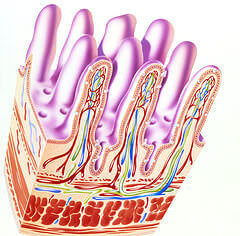
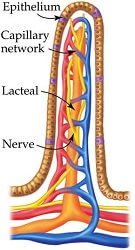
5. Egestion
The food not digested by human digestive enzymes goes from ileum to colon. Colon is the first part of large intestine. Here, water is absorbed from undigested food. Due to this, the undigested food becomes solid. This undigested solid food is stored temporarily in the rectum. Rectum is the last part of large intestine. From rectum the undigested solid food is finally removed out of the body through anus.
Test Your Understanding and Answer These Questions:
- Explain various processes of nutrition taking place in the digestive system of human beings.
- Give names of various digestive glands present in human beings. Also give their functions.
- What is the function of small intestine and large intestine in digestion of food in human beings?
- How food is absorbed in small intestine? Explain with the help of a diagram.
- What are the functions of liver and pancreas?
- What is the function of HCl in the process of digestion in stomach?
- What is the importance of bile?
- Explain digestion in mouth in human beings.
- Give names of the salivary glands found in human beings and also give their location.
- What are the functions of saliva?
- What are functions of tongue in human beings?
- What is the importance of HCl in digestion of proteins in human beings?
- What are the functions of small intestine in humans?
- Give difference between chyme and chyle.
- What is the length of alimentary canal in humans?
- Give the name of the organ in which bile is stored.
- Name the largest gland present in human body.
- Give the names of secretions of liver and pancreas.
- Which organ of the alimentary canal absorbs most of water?
- Give the names of two parts of small intestine.
- Give the names of two parts of large intestine.
